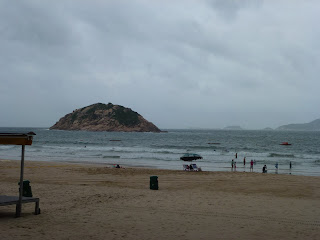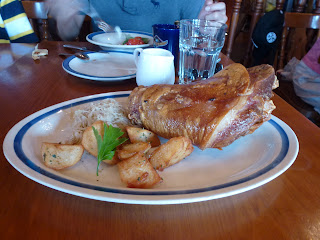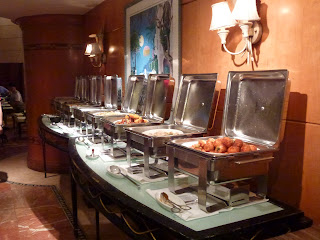I know I've set a new record in being late, but family matters (and a good dose of laziness!) intervened over the weekend.
Friday, August 17.
Friday, August 17.
A friend with a car offered to drive us around the to the extremes of this city, for a tour of places rarely seen by visitors, and even locals without private vehicles.
First, a drive on Strategic Route 7, across the top of Kowloon.
First, a drive on Strategic Route 7, across the top of Kowloon.
 |
| Kowloon Bay (九龍灣) MTR Station. |
 |
| MTR headquarters, at Kowloon Bay. |
 |
| Ngau Tau Kok (牛頭角, lit. Bull's Head Cape) MTR Station. |
Which brought us to the Eastern Harbour Crossing (東區海底隧道), the easternmost of the three vehicular cross-harbour tunnels linking Hong Kong Island with Kowloon.
On the Hong Kong side, we pass familiar landmarks like Taikoo Shing:
before heading out to the easternmost part of northern, densely populated Hong Kong Island at Heng Fa Chuen (杏花邨, 50 or so identical residential towers forming a self-contained community, with an MTR station and mall in the centre, developed by MTR Corporation) and Chai Wan (柴灣), the eastern terminus of the MTR's Island Line.
 |
| Yes, they are all completely identical. |
a narrow, two-lane passage from the densely populated northern coast of the island to the rugged, sparse southeastern coast.
Just a few minutes from Chai Wan, the endless urban jungle turns into actual jungle:
...with an Ikea truck to remind you that you're still in the middle of one of the world's economic hubs.
We turned off onto Shek O Road (石澳道), another mountain road leading to, surprise, Shek O, a small town at the south-easternmost tip of the island.
Oh, I forgot to mention. A typhoon just hit the night before, and the Signal No. 3 was still up,
leading to a rather empty parking lot and beach.
There was no time to go for a dip, however. There were things to be seen!
Heading back onto Tai Tam Road,we reach the namesake of the road, Tai Tam, and the artificial Tai Tam Reservoirs (大潭水塘) that were created from the dam that the road sits on top of.
 |
| The upper reservoir on the right... |
 |
| and the outflow into the sea on the left. |
until you come across that double-decker bus that doesn't quite fit in its own lane.
Luckily, we didn't see any. Just cars and minibuses. No backing up across the dam to let an oversized bus by!
Obviously, with this kind of serenity just minutes from the city centre, some folks are bound to build luxury houses here. These ones are on the mountainside facing the South China Sea.
We were going to the popular, tourist-friendly town of Stanley (赤柱), on another peninsula off the south coast of the island, for lunch.The name Stanley comes from an English Lord, the 19th of his line, who was the Secretary of State for War and the Colonies from 1883 to 1884. Go figure.
It was chosen as the site for the reconstruction of many former Central landmarks, deconstructed in the pursuit of progress.
This building, Murray House (美利樓), was once a military barracks until in 1982, the I.M. Pei's Bank of China Tower was to be built on top of it. It was quickly dismantled and eventually relocated to this seaside location in Stanley, where it was converted into a museum, with the upper floors turned into restaurants.
It was at one of these restaurants:
that we ate.
King Ludwig Beerhall (known in Chinese as simply 德國餐廳, or "German Restaurant"), purports to serve authentic German (by this I think they mean Bavarian) specialties such as Schweinshaxe, a Bavarian roasted ham hock. Their décor is rather over the top:
so more points for effort/kitsch!
They had a kid's menu, out of which my brother picked fish and chips, that came with fruit punch. Which came before any of our food.
A "beer pretzel". Tasted like any other soft pretzel. Although they did have a bunch of (ostensibly German) beers on tap that I had never seen before.
Lunch meals came with a (Greek!?) salad,
and a cream (of nothing!) soup.
And here's the schweinshaxe, with sauerkraut and potatoes on the side.
Here's a small platter of sausages, which we are told are shipped in from a "master" in Germany.
For dessert, the kid's meal had ice-cream:
while the rest of us had chocolate cake.
We headed out for a short walk along the coast.
Blake Pier (卜公碼頭) was another part of Central that was shipped over here as times changed.
Famous for being the pier that all dignitaries came into and left the city from, Blake Pier was demolished in 1993 as the harbour around it was being reclaimed for more skyscrapers. The roof was the only thing that survived, first being moved to a part in Wong Tai Sin, before finally being put over a reconstructed pier in Stanley in 2007.
On the way out of southern Hong Kong Island, we pass Repulse Bay (淺水灣, lit. Shallow Water Bay), the most popular beach in the city, and the site of some luxury condos:
back in Wan Chai, I don't think I have to say anything about our drive through Admirality and Central:
We crossed the Western Harbour Crossing,
and went onto the newest bridge in the city, Stonecutter's Bridge (昂船洲大橋), linking Tsing Yi to Kowloon.
Signal No. 3 was still up...
and here's the view of West Kowloon and Hong Kong from the bridge.
At Tsing Yi, we pass the massive container terminals 8 and 9:
before driving past Tsuen Wan into the New Territories' mountains.
We stopped here.
Tai Mo Shan, at 957m, is the highest point in Hong Kong. This rest stop is about halfway up the mountain,
with some spectacular views of Tsuen Wan, Kowloon, and Hong Kong.
 |
| Nina Tower again! |
As we slowly ascended the winding road,

The way became foggier and foggier as we approached the altitude of the clouds above the city.

This is the point at which vehicles must stop. The rest of the journey to the summit must be made on foot, something which we were not about to do.
Some 700 or 800 metres up, this is the view of the plains in the northwestern New Territories.
 |
| Shek Kong Airfield in the foreground. |
 |
| Yuen Long. |
I found this sign to be a bit awkwardly hilarious for what it was trying to say.
And sprayed onto the road was this:
"Vindication of six-four", June 4, 1989 being the date of the brutal crackdown on the Tian'anmen Square Protests. I will make a politics post, but only after I get back.
We had one last place to go to.
We'd already been to the southeastern corner of the territory, now we were headed to the northwestern.

A relatively rural area facing mainland China, Tsim Bei Tsui (尖鼻咀) is one of the last places that a tourist would ever visit. Nearly impossible to get to without a car, it offers some interesting sights.
 |
| Shenzhen in the distance. |
Like massive spiders.
Neighbouring Lau Fau Shan (流浮山) offers a similar experience, facing the Shenzhen Bay and its bridge.

It was low tide when we arrived at the coast, about an hour before sunset.
One of the less used crossings between Hong Kong and mainland china, the Shenzhen Bay Bridge is a relatively new one, crossing a rather wide part of Shenzhen Bay.
Could someone tell me what these are? Some sort of fish with legs... (and no, not tadpoles!)
For dinner, we went to a resort town south of Tuen Mun.
The Gold Coast, the site of an artificial beach, is a popular quick getaway from the city for locals - like the Caribbean, but a lot closer and a lot cheaper.
The hotel, like every other hotel in the city, boasts a rather overpriced buffet dinner.
 |
| Tasteless caviar on a scallop. |
 |
| They really like their "pancakes" around these parts, don't they. |
But of course, with these things, you\'re never paying for the food, just the ambience, service, and relaxed feel, a good antidote to the hectic pace of life outside these walls.






































































































No comments:
Post a Comment